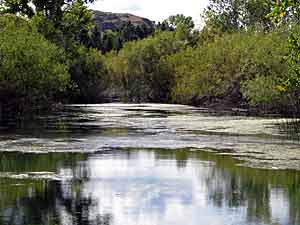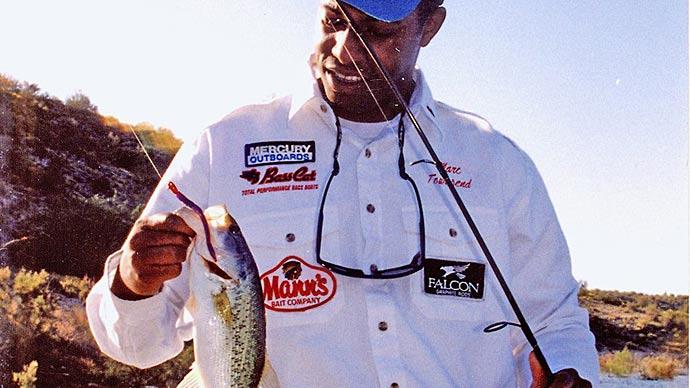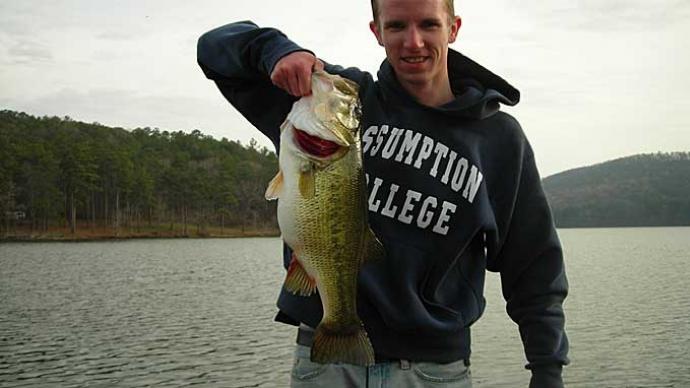
Summer had come to the city. It was a sticky 90-degree day with 95-percent humidity. Few anglers were fishing the local ponds and small lakes that dot the city. Heat warnings led off the morning news in the region. For the most part, folks attempted to get in their recreation before the mercury rose and the techno gear clung to them like sweat coated sausage casings. It hadn't been the worst summer, but by late August the dry season made small impoundments feel like bath water and evaporated down the water level. Algae and plankton further deepened the hue of the city's generally off colored water columns.
So you fished early or late this time of year, with the warmer, brighter hours left for other daily pursuits that did not involve fins. Urban angling is a favorite of mine, giving me mini-fishing outings on days I cannot arrange a longer trip. These quick fishing trips are productive. My catch ratio is usually good, and I'm just out for some fun and that works great. Nighttime fishing in the city during summer has other considerations. Insects, unsavory types and things that go bump are out. So despite the heat of an August afternoon, nocturnal wanderings were eschewed in favor of fishing the following morning, and hopefully a bit of shoreline shade.
I decided to fish the main city lake for a couple of reasons. It is a waterway I've fished often, under all conditions and 12 months a year. I had an idea where fish would be located, even in the steam bath. I chose to fish at the bridge, a newer structure of concrete and steel that replaced the previous wood and iron span. My son and I often fished this area when he was young, and he named it Jackson's Island, after the landform dubbed by Mark Twain in Tom Sawyer and Huckleberry Finn. This is a great spot for black and white crappies, bluegills and bass, a few nice channel catfish and white perch to sweeten the pot. But the new bridge was not as effective a fish magnet as the old, and other areas of the lake became more productive. I suspected there were fish to be caught at the new bridge, even on an August afternoon. The nostalgia and memories guided me where to cast more than my fishing log notes.
Since the deeper reaches of the lake were beyond my present shaded position at the bridge, my strategy was to see what the cover and structure of the bridge and old wood supports might harbor beyond those first two crappies. A few gulps from my water bottle and I sat on the bulkhead and scanned for my next target. I think at this point I noticed the water level was quite a bit lower than I had first realized, just an observation at that point.
Across and to my left two weedy clumps of bushes grew out from the bulkhead, and seemed likely targets. I arose flipped the tiny plastic worm under the first bush, and had a strike which I missed. Bluegill, I surmised, as for the next hour or so I landed about a dozen darkly colored specimens from the brush. The action stopped, and the deeper water in the center of the channel beneath the bridge yielded nothing further.
However, on occasion the uneven corrugated cut-outs of the bulkhead I was fishing from, harbor a fish or two. By flipping parallel casts, I might put a lure on the nose of a bass and elicit a strike. It did not take long. On my third cast the sparkling chartreuse worm stopped dead 15 feet along the bulkhead. Had I let it sink too far and snagged bottom, caught a loose piece of bulkhead or was it a fish? Before that thought was fully realized, I felt and saw the line jerk away from the bulkhead and set the hook with as much gusto as you do with 2-pound test and a 4-1/2 foot panfish rod.
Introductions were quickly made, as a 3-pound bass leaped through the surface film in a classical gill-rattling jump, impressive for a warm water largemouth, and the first of four the fish afforded. The last was one for the books. But before that, it was touch and go, backing off the drag, feathering the reel with the anti-reverse off, as both the bass and I prepared for what was to be a memorable denouncement. This was where the landing strategy comes into play, and normally, another jump or two and I would lead the fish along side of the bulkhead for a traditional lip grip landing, hook removal and release. It was then that I remembered the low water level and as I gazed down into the most recent swirl the bass had made, I realized my reach was going to be short by almost two feet.
But I had to try, there was no place to beach the fish and trying to lift the heft I felt on my line was not an option. I unbuckled my tackle belt and lay face down across the bulkhead, hanging over the edge as far as I could. My rod was held in my left hand and I lifted and played the tiring bass toward me. As the fish got closer, resisting slowly against the light but persistent pressure I was applying, I reached awkwardly toward the water, able to come within a foot and a half perhaps of the surface.
But as I stared at the fish with my mind full of only "what to do next", the bass made the decision for me, but not in the traditional way, by pulling out against the pressure I was applying or throwing the hook on the last jump. I saw the bass quiver beneath the surface and gather for a final leap. I am not sure what if any expectations the bass had about our predicament, but it had to be as surprised as me as to what happened next.
With my left arm extending the rod skyward to try and keep the bass coming, I strained to find a way to reach the fish, but could not. Bent on regaining its freedom, that largemouth did not just wallow on the surface, but launched one last Polaris missile leap, bringing its head, or more precisely lower jaw, about 20 inches above the water line. Or another way to put, the bass jumped high enough into the air for me to lip it. In my supine position it happened literally right in front of my face.
I latched on to the startled bass, rolled to my haunches, popped the jig and worm out of the corner of its mouth and reached over to my tackle belt for a tape measure. Eighteen and a half inches, which I then lowered back as near to the surface as possible, achieving a nice smooth head first entry for the bass. I had never experienced anything quite like that before, and in discussions with others and some amusing research, could not find the exact duplicate of the occurrence. I was hotter and sweatier than I had planned, but had a few fish during my outing and one of those experiences that only comes from being on the water.
So the truth is, bass are where you find them. And at least once, that was in mid air, over the water on a hot summer's day in the city.
Wayne Heinze
From along the edge of the Jersey Pine Barrens



